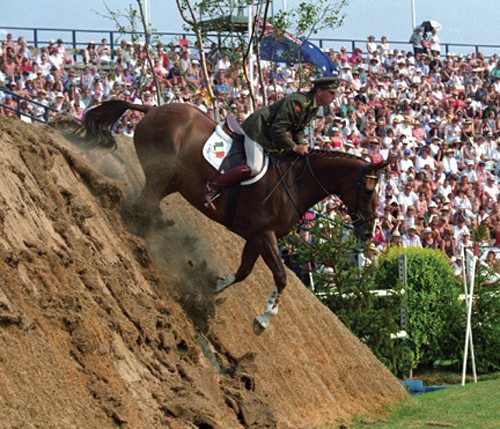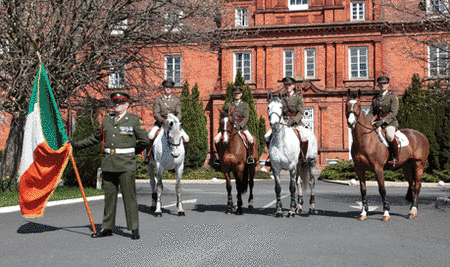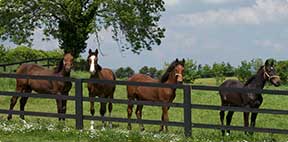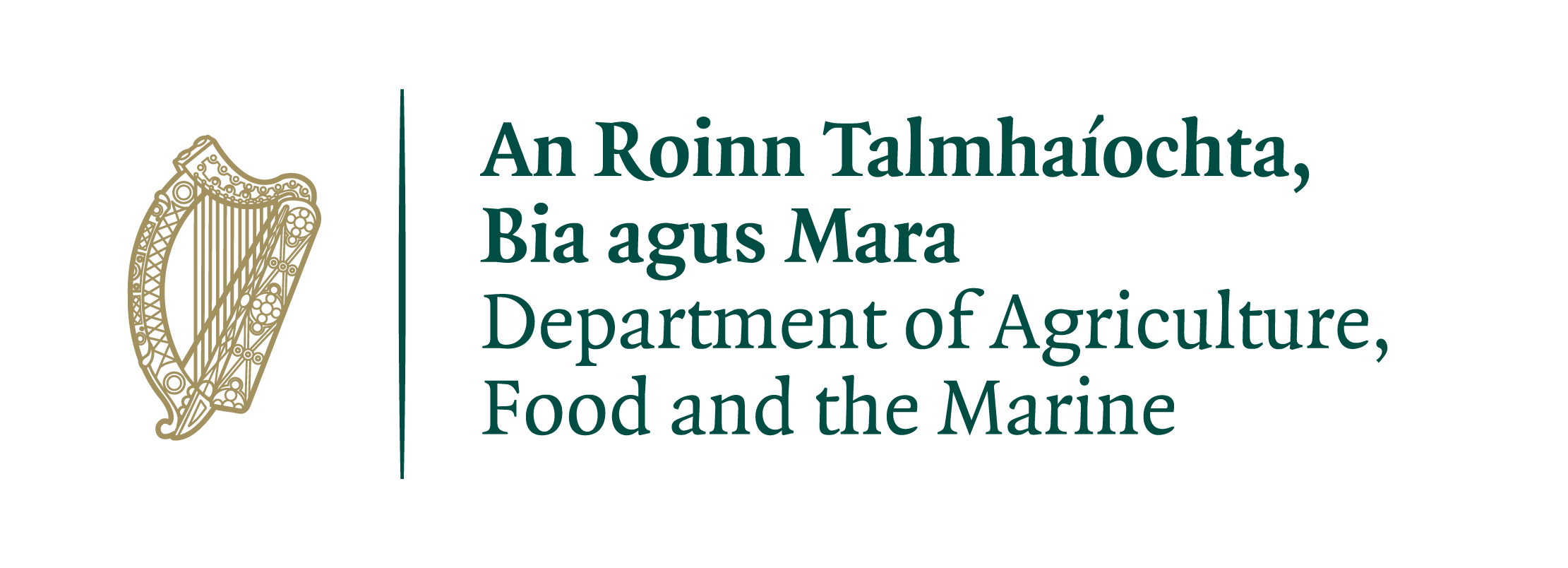The Irish Equitation School – flying the flag for Irish horses since 1926
The Irish Sports Horse industry is worth over 800 million to the Irish economy. Global recognition of Ireland as land of horse is brought to the fore by the Irish army horse’s and their riders. The Irish Equitation School is an asset that is invaluable to Ireland’s economy and sport horse industry.
“Since the foundation of the Equitation School riders have been the backbone of Irish show-jumping and event teams. Army riders have represented Ireland at Olympic, World and European Championship level in Show-jumping and Three Day Eventing”.
Situated in one of Europe’s most historic parks the Phoenix Park, the Irish Army Equitation School is located at Mckee Barracks. The stable block built in 1888, comprises of red bricked Victorian buildings of significant architectural merit. These redbrick stable blocks are still in use as housing for the army’s competition horses. Along with modern facilities , the horses can be seen being exercised in the 1000 acres of parkland in the heart of Dublin’s capital city
It’s retired officers participate fully and effectively in the equestrian industry’s structural bodies, helping in a major way to develop the industry and the sport into the future.
The Irish Army Equitation School is historic, iconic, and relevant institution we hope you enjoy reading about it’s history.
Enjoy this piece of footage courtesy of the RTE ARCHIVES: from the Irish Equitation School 1963
HISTORY OF THE IRISH EQUITATION SCHOOL
credit Horse Sport Ireland Press Office 2012
Its establishment in 1926 came about under extraordinary circumstances.
We have to remember that in 1926 Ireland had come out of a period of revolution commencing with the 1916 Rising, followed by the War Of Independence from 1919 – 1921, which again was followed by the Civil War which lasted to the end of 1923.
It has to be appreciated that there would still be growing pains with the new State seeking to establish itself, and soldiers who had been on opposing sides during the Civil War had to put their differences aside and help create a new nation.
Under those circumstances – the founding fathers were a unique combination – Judge William Wylie, a Presbyterian from Coleraine who was educated in Trinity College and graduated with a first-class honours Law Degree to become the Crown prosecutor at the Military Court Marshal Tribunals, which tried the captured rebels after 1916, he was joined by William T. Cosgrave who was one of the volunteers who saw action in the 1916 Rising, and was subsequently arrested, court marshalled, and sentenced to death. The death sentence was commuted to penal servitude for life and Judge Wylie is credited with having been influential in that computation of the sentence.
Both of these men had one thing in common, and that was their passion for the Irish Horse, and both of them saw no difficulty in putting their differences to one side and co-operated in a most extraordinary adventure: and that was the establishment of an Irish Army Equitation School at McKee Barracks – then known as Marlborough Barracks in Dublin.
This ambitious undertaking was first mooted in the autumn of 1925 and was facilitated by the Royal Dublin Society of which Judge Wylie was a prominent council member. The proposal was made to the Government of which William T. Cosgrave was President of the Executive Council – that position would now be known as Taoiseach. In the nature of things, the bureaucracy of the Civil Service spent some time looking into the matter, but at the end of the day they were aware of the interest in the project by the president of the Executive Council William T. Cosgrave so the go ahead was given in the summer of 1926. A decision was taken that the Equitation School would have a full Army Team competing at the RDS Horse Show in August three months later.
You can imagine with three months to acquire horses, train them, pick riders, train them and compete against international teams from Britain, France and Germany was a tall order. Nonetheless, the Army Equitation School under its Officer Commanding, Major Liam Hoolan, got down to work with steely determination.
One of the first recruits was Captain Jed O’Dwyer from Co. Tipperary, he was joined by Captain Dan Corry from Co. Galway and Captain Cyril Harty from Co. Limerick. Following that, horses had to be found because the Irish Army at that time did not have a cavalry. They had atransport unit, and the horses were used for pulling carts and general transport, so the princely sum of £1,615 was spent on the purchase of potential showjumpers. That was in May 1926. Those first horses were named from heroic ancient Irish names: Finghin, An Craobh Ruadh, Roisin Dubh and Ferdia.
From May to the beginning of August you can imagine was an extremely short period of time to get both riders and horses trained in the art of showjumping. The riders of course had some horsemanship skills in hunting and in the case of Cyril Harty some showjumping and point-to pointing,but they had no expertise whatsoever in the art of showjumping.
The horses of course were straight in from the fields and had to be trained from scratch, so it was a brave and daring adventure to embark on: to compete at International level with this inexperienced combination. The whole enterprise was helped greatly by another outstanding officer: Colonel Michael Hogan who was a brother of the Minister for Agriculture of the day, Paddy Hogan from Loughrea, Co.Galway.
When the fateful day came, at the start of the RDS Horse Show in August of 1926, the first competition was for the confined Military Class and it was an amazing achievement that Captain Jed O’Dwyer took runner-up position, and Captain Dan Corry took fourth place against the teeth of competition from Army Personnel from a number of European countries.
A sign of those times was captured in a report in The Irish Times the following day, Saturday 7th August, when it noted that when the British Team took a temporary lead in Friday’s Aga Khan Cup “there was tumultuous applause around the ground”. Captain Jed O’Dwyer is recorded as saying “I had a strong feeling that at least half of the packed stands on opening day were hoping for a win by Britain”.
The Aga Khan, who was a recognised supporter and enthusiast of the Irish Equestrian Industry, presented a fabulous cup called the Aga Khan Trophy for the Nations’ Cup at the RDS in Dublin, and to this day that is one of the most sought after and prized competitions to be staged anywhere in the world.
For the Nations’ Cup, Captains Dan Corry, Jed O’Dwyer and Cyril Harty lined up for the Irish Army against Army teams from Britain, France, Belgium, Holland and Switzerland. A record crowd of 34,000 thronged every available space around the RDS arena. The stage was set.
An heroic performance by Captain Dan Corry on Finghin, Captain Cyril Harty on Cuchulainn, and Captain Jed O’Dwyer on Oisin produced an outstanding performance to reach the runner-up spot behind Switzerland and ahead of Britain, France, Holland and Belgium.
As is the usual Irish reaction, that second was greeted as a win by the Irish supporters and euphoria permeated the entire Irish equestrian world.
So the Irish Army Team in their sparkling new uniforms had made an outstanding start, but of course there was a long way to go, and the leadership of Colonel Michael Hogan – the Minister for Agriculture Paddy Hogan’s brother who was appointed Assistant Quarter Master
General the following year – set about an intensive training programme for the Equitation School. He garnered the services of the world-famous Russian riding expert Colonel Paul Rodzianko as trainer. Rodzianko’s training stint with the Equitation School began in 1928 andended in 1931 and there is no doubt that he was influential in introducing new riding techniques and his influence was a major contributory factor to the success of the Irish Army’s Nations Cup Teams during the 1930s. Rodzianko’s students, Captains Corry, Harty and O’Dwyer made rapid progress and in the Nations’ Cup at the RDS in1928 they won with a very impressive overall score defeating Britain and France. To the strains of the National Anthem, the Aga Khan Trophy was presented to the Irish trio by the Governor General of the Irish Free State, James McNeill.
The Irish Army Team had arrived. The Equitation School had measured up to the job!
New recruits Lieutenant Fred Aherne from Co. Meath, Jack Stack from Cork, and Tom Fennelly from Laois joined the squad. During the decade of the 1930s this combination of riders along with horses such as Limerick Lace, Kilmallock, Miss Ireland, Red Hugh, Ireland’s Own and Blarney Castle performed magnificently in Nations’ Cup events and Grand Prix in the major cities of Europe right up to the outbreak of the Second World War. The Army Team and its horses flew the Irish flag and promoted an exceptionally positive image of Ireland internationally; at a time when little was known of this new nation.
Additionally, the Irish horse was promoted to an extent never before seen which reflected very positively on soaring exports of Irish horses to countries around Europe, in particular sport horses which in turn benefited farm families throughout the length and breadth of the country. It is fair to say that the present day positive image of the Irish horse had its foundations in the performances of the Irish Army on horseback – ambassadors on horseback.
Nonetheless, finance was still a problem during the 1930s and all options had to be considered. For example: “Just three riders were sent on the 1933 North American tour.Captain Dan Corry, who was in charge, was joined by Captains Fred Aherne and Cyril Harty. Matters went well enough for them on their first visit to Chicago as Corry on Shannon Power and Aherne on Ireland’s Own scored individual wins, while Corry on Slievenamon and Aherne on Ireland’s Own teamed up to take the pair event. However, their curtailed team of three hit a major snag at Madison Square Garden when it was discovered that the relay event there had been changed to teams of four. The matter was solved when Corry called on one of his grooms to fill the extra slot. Twenty-seven-year-old Cavan man William Finlay did the honours on the difficult ride Ireland’s Own to help Ireland win the event. On this, the first and only occasion in which one of the grooms rode an army horse in major international competition, Captain Corry insisted that Private Finlay ride forward to receive the Westchester Cup. According to newspaper reports of the event,Finlay got a massive reception from the packed Madison Square crowd.”
Back in the saddle in 1946, after the war, new recruits such as Bill Mullins from Kilkenny, Louie Magee from Meath as well as Michael Tubridy from Co. Clare came on board.The format for the Nations’ Cup Games had also changed, and after the war in 1947 Nations’ Cup events would no longer be confined to military riders. That meant that the men from the Army were going out to compete in national and international shows against opponents who were trained professionals.
Nonetheless, the Army Team picked up where they left off before the War and won the Aga Khan Trophy at the RDS Dublin Horse Show in 1946. They continued to perform admirably throughout the remainder of the decade.
New recruits entered the team in the 1950s such as Kevin Barry from Charleville and Billy Ringrose from Limerick who joined in 1954. In October 1956 Seamus Hayes took up duty as trainer with the Equitation School. The Army Team continued to perform well throughout Europe and North America during the 1950s and importantly and luckily in 1958 the army acquired a new horse for £1,500 – a substantial sum inthose days. Its name was Loch An Easpaig. Also at that time civilian riders such as Tommy Wade, Leslie Fitzpatrick, Tommy Brennan and Diana Connolly-Carew and Iris Kellett were providing keen competitionfor the army riders.
At the end of the 1950s and early 1960s, live television also contributedto a huge upsurge of interest in showjumping. In 1961 Ned Campionjoined the squad and in 1962 Ronnie MacMahon joined the school. The Army Team continued their successful campaign in European cities andalso North America during the 1960s. A fundamental change took place in 1963 when civilian riders joined the Irish Nations’ Cup Team for the first time. In 1963 with a team made upof Diana Connolly-Carew on Barrymore, Tommy Wade on Dundrum,Seamus Hayes on Good Bye and Billy Ringrose on Loch An Easpaig, Ireland again won the coveted Aga Khan Trophy.
During the second half of the 1960s and into the 1970s the team continued its sterling performances both at home and abroad. The riders included the new recruits Ned Campion, Ronnie MacMahon and Larry Kiely.
From the mid 1970s onwards new recruits like Gerry Mullins, Brian McSweeney, Con Power, John Ledingham, Ulick McEaddy and Gerry O’Gorman joined the school. New horses that joined the squad during the 1970s were Coolronan, and in Eventing, San Carlos and of course the mighty Rockbarton. Civilian riders provided great competition with the likes of Paul Darraghon Heather Honey, James Kiernan on Condy and Eddie Macken on Boomerang. At the end of the 1970s new recruits such as Pat McCartan, David Foster, John Roche and Pat Coleman along with John Ledingham from Clashmore in Waterford joined the school, and on horses such asKilbaha, and Kilcoltrin, they became a frequent winning combination during the 1990s. The 1990s was another good decade for Army riders with participants such as Sean Daly, Eamonn O’Donoghue, Billy Ringrose, and Ned Campion flying the flag for Ireland in many capitals around Europe and the USA. With horses such as Garraun, Rincoola Abu,Castle Pollard, Millstreet Ruby, and the emerging Cruising to the fore, famous victories in places such as Hickstead and Spruce Meadows in Calgary were achieved.
The first decade of the new millennium saw the Army continuing to fly the flag to great effect worldwide. Additionally, a new recruit, the first female riding officer, Lieutenant Danielle Quinlivan from Kanturk, Co. Cork cut quite a dash in her new army uniform. Also a new influx including Shane Carey, David O’Brien and Gerry Flynn were to make their mark during the decade. Gerry Flynn won the Grand Prix at the 2007 Dublin Horse Show with Mo Chroi,and Captain Geoff Curran and Kilkishan won the Eventing World Cup Qualifier in Tattersalls in 2008.
If you would like to read more about the Irish Equitation School, a book called Ambassadors on Horseback by Michael Slavin, is a fantastic read.
16132 total views, 2 today











